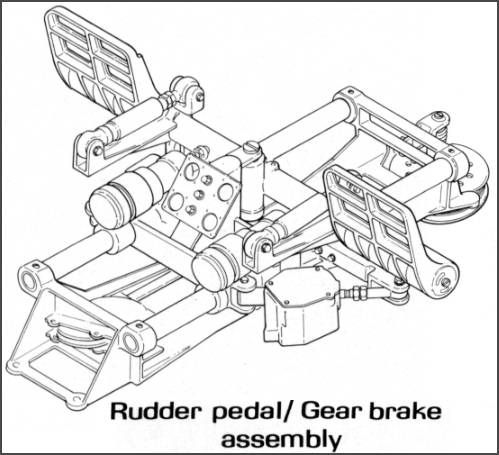How to install the app on iOS
Follow along with the video below to see how to install our site as a web app on your home screen.
Note: This feature may not be available in some browsers.
You are using an out of date browser. It may not display this or other websites correctly.
You should upgrade or use an alternative browser.
You should upgrade or use an alternative browser.
Combat Aircraft Projects & Designs - Index in 2nd post
- Thread starter Manticore
- Start date
Manticore
RETIRED MOD

- Joined
- Jan 18, 2009
- Messages
- 10,115
- Reaction score
- 114
- Country
- Location
The air war experience in Vietnam, where the lack of maneuverability of US fighters at transonic speeds provided advantages to nimble enemy fighters, was the stimulus for the Lightweight Fighter program. The Air Force and designers of the Lightweight Fighter therefore placed great emphasis on achieving unprecedented transonic maneuver capability with excellent handling qualities.
In January 1972, the Lightweight Fighter Program solicited design specifications from several American manufacturers. Participants were told to tailor their specifications toward the goal of developing a true air superiority lightweight fighter. General Dynamics and Northrop were asked to build prototypes, which could be evaluated with no promise of a follow-on production contract. These were to be strictly technology demonstrators. The two contractors were given creative freedom to build their own vision of a lightweight air superiority fighter, with only a limited number of specified performance goals. Northrop produced the twin-engine YF-17, using breakthrough aerodynamic technologies and two high-thrust engines. General Dynamics countered with the compact YF-16, built around a single F100 engine.
The evolution of the YF-16 design at LMTAS included studies of configuration variables such as wing design, maneuvering devices, number and location of engines, control surfaces, number and location of tail surfaces, and structural concepts. As the configuration options matured, two candidate configurations competed for priority. The first configuration was a simple wing, body, and empennage design, while the second design was a twin-tailed, blended-wing body with vertical and horizontal tails on booms. The LMTAS team selected the best features of both configurations for the final YF-16 design. After considerations of performance, stability, and control were addressed, the YF-16 configuration incorporated a rather wide, blended forebody that produced strong vortices at moderate angles of attack. LMTAS had attempted to weaken the strength of the vortices by promoting attached flow, but these attempts were not successful.
http://dc299.*******.com/img/-TA_MYyI/0.5505849817969517/Northrop_YF-17_Cobra_060810-F-.jpghttp://dc191.*******.com/img/QgR0I96r/YF-17_F-18.pnghttp://dc218.*******.com/img/OOVnd0h7/0.40926052103955024/f16_jf17.jpg
In January 1972, the Lightweight Fighter Program solicited design specifications from several American manufacturers. Participants were told to tailor their specifications toward the goal of developing a true air superiority lightweight fighter. General Dynamics and Northrop were asked to build prototypes, which could be evaluated with no promise of a follow-on production contract. These were to be strictly technology demonstrators. The two contractors were given creative freedom to build their own vision of a lightweight air superiority fighter, with only a limited number of specified performance goals. Northrop produced the twin-engine YF-17, using breakthrough aerodynamic technologies and two high-thrust engines. General Dynamics countered with the compact YF-16, built around a single F100 engine.
The evolution of the YF-16 design at LMTAS included studies of configuration variables such as wing design, maneuvering devices, number and location of engines, control surfaces, number and location of tail surfaces, and structural concepts. As the configuration options matured, two candidate configurations competed for priority. The first configuration was a simple wing, body, and empennage design, while the second design was a twin-tailed, blended-wing body with vertical and horizontal tails on booms. The LMTAS team selected the best features of both configurations for the final YF-16 design. After considerations of performance, stability, and control were addressed, the YF-16 configuration incorporated a rather wide, blended forebody that produced strong vortices at moderate angles of attack. LMTAS had attempted to weaken the strength of the vortices by promoting attached flow, but these attempts were not successful.
http://dc299.*******.com/img/-TA_MYyI/0.5505849817969517/Northrop_YF-17_Cobra_060810-F-.jpghttp://dc191.*******.com/img/QgR0I96r/YF-17_F-18.pnghttp://dc218.*******.com/img/OOVnd0h7/0.40926052103955024/f16_jf17.jpg
Manticore
RETIRED MOD

- Joined
- Jan 18, 2009
- Messages
- 10,115
- Reaction score
- 114
- Country
- Location
eurofighter evolution
http://dc303.*******.com/img/RZbWh3SQ/0.7054270512512398/1976_P91.jpghttp://dc303.*******.com/img/n1-AxINE/0.6223167760981352/1976_P92b.jpghttp://dc303.*******.com/img/uZyx0O2f/0.8949119836352151/1976-P159.jpghttp://dc303.*******.com/img/PXnjdgJz/0.3513432886464747/1976-P158.jpg
http://dc303.*******.com/img/RZbWh3SQ/0.7054270512512398/1976_P91.jpghttp://dc303.*******.com/img/n1-AxINE/0.6223167760981352/1976_P92b.jpghttp://dc303.*******.com/img/uZyx0O2f/0.8949119836352151/1976-P159.jpghttp://dc303.*******.com/img/PXnjdgJz/0.3513432886464747/1976-P158.jpg
Manticore
RETIRED MOD

- Joined
- Jan 18, 2009
- Messages
- 10,115
- Reaction score
- 114
- Country
- Location
http://dc303.*******.com/img/ULymT4de/0.8288892366504627/1977_P96.jpghttp://dc303.*******.com/img/uolZxLTo/0.817233555367098/1977_P103c.jpghttp://dc303.*******.com/img/TgY-eJWP/0.46030649037217597/1978_P96F.jpghttp://dc303.*******.com/img/E-l-Hvar/0.4166390402654141/1978_P103.jpg
Manticore
RETIRED MOD

- Joined
- Jan 18, 2009
- Messages
- 10,115
- Reaction score
- 114
- Country
- Location
http://dc303.*******.com/img/utrq060L/0.012150278126356273/1978_P1205b.jpghttp://dc303.*******.com/img/C2uISB5Z/0.20603899327644903/1979_ECFa.jpghttp://dc303.*******.com/img/K8cIoxzS/0.10205194852470023/1980_P106b.jpghttp://dc303.*******.com/img/UL32xGU-/0.016954615568107623/1981_P110a.jpg
Manticore
RETIRED MOD

- Joined
- Jan 18, 2009
- Messages
- 10,115
- Reaction score
- 114
- Country
- Location
http://dc303.*******.com/img/xMdJwNzU/0.1504878512374095/1982_ACAe.jpghttp://dc303.*******.com/img/AsH6WE_K/0.0678613893223915/1985_EFAa.jpghttp://dc303.*******.com/img/fX68hbGk/0.4801943066869512/GER-_VFW_Fokker_TKF-90_2.jpg
Similar threads
- Replies
- 94
- Views
- 193K
- Replies
- 83
- Views
- 76K
- Replies
- 90
- Views
- 36K








